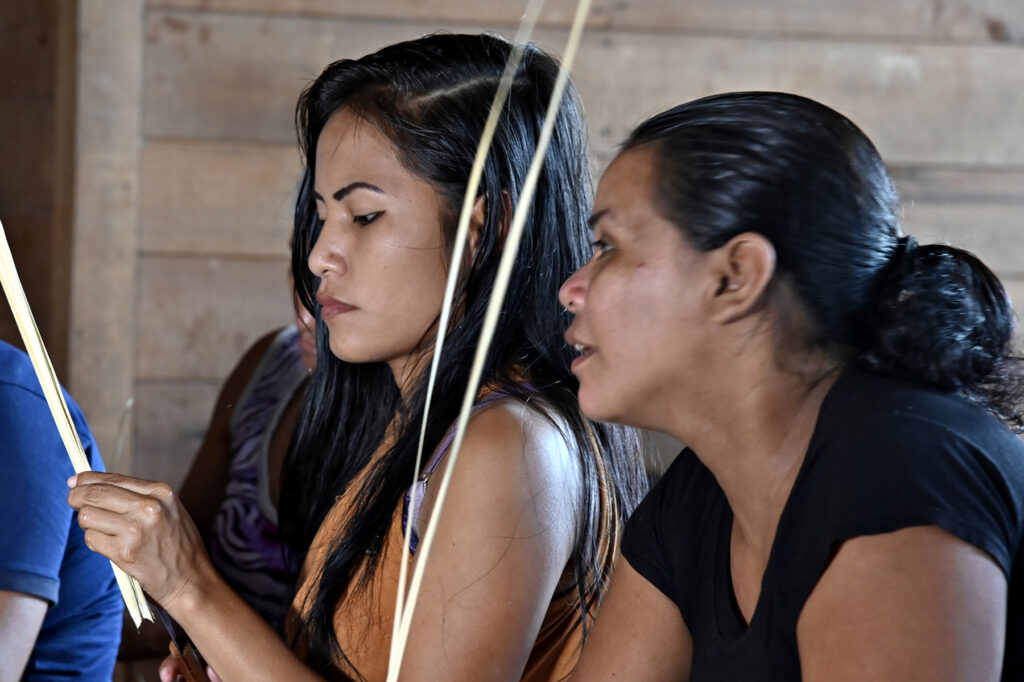From the splints of Arumã and Bacaba, Paumari women weave dreams and ancestry
Through crafts, they strengthen the culture of the people and the political organization of women
AI generated audio
Through crafts, they strengthen the culture of the people and the political organization of women
By Talita Oliveira | OPAN
“We, as women, decided to pull what was already inside us: our knowledge of nature, our knowledge of weaving”, recalls Kamelice Paumari, 21, coordinator of the thematic coordination of the work of women of the Associação indígena do Povo das Águas (AIPA). Before resuming the production of handicrafts, women began to organize themselves through the kitchen, during the work carried out by them during the pirarucu fishing period. Then they decided that they could participate in other spaces together with the men.

The handicrafts of the Paumari people are known throughout the Purus basin, with records in the first reports of travelers in the 18th century. However, currently the production of baskets, paneiros, mats and pads was being practiced by a few women – specifically three – and there was the fear that knowledge would be lost. In 2021, Deusilene Paumari, at the time president of AIPA, was invited to participate in a training aimed at indigenous women, called among relatives, organized by OPAN and the International Institute of Education of Brazil (IEB). In the training, in addition to learning about the management of associations and projects, Deusilene and the Paumari women were invited to prepare and execute a project of ten thousand reais.
“At the beginning of our work, Deusilene gathered the women and said: Guys, we have this resource, what can we invest in to help us? Many thought of kitchen utensils, but we said no, we already have it. We can invest in something that is best for us. We, as women, decided to pull what was already inside us: our knowledge of nature, knowledge to weave”, says Kamelice about the resumption of work with handicrafts.
Since then, several meetings have been held, both between Paumari women from Tapauá, and between them and the Paumari of the Paumari Indigenous Land of Lago Marahã (also located in the Middle Purus), which maintains the culture of Teçume. The meetings aimed to provide the transmission of knowledge among the most experienced women in the art and those who need to practice more, or were starting to learn, in addition to learning new techniques and discussions about prices and the market.

“Today, about 17 women know how to weave their own crafts and before they didn’t even know how to weave a splint. it’s hard? It is. But we want and we are being able to build everyone together. It motivates even more when we can see each woman happy with her crafts. We evolve so quickly in the knowledge of each learning, of each meaning of our Paumari graphics that goes in the baskets”, says Kamelice, moved.
Since 2013, the strengthening of the social organization and territorial management of the Paumari people has been supported by Raízes do Purus, a project carried out by Operation Amazônia Nativa (OPAN), sponsored by Petrobras and the federal government.
Weave, share and strengthen
Women’s meetings are also important moments of strengthening the culture of the Paumari people, as they promote the meeting between the youngest and the elders, awakening the desire to teach and learn more and more. They are also an opportunity to share dreams and desires among Paumari women, strengthening their social organization and political mobilization to continue occupying other strategic spaces.
“My dear grandma Laurinda told me that she is very happy to see women gathering to weave. Today she is happy that women are valuing and learning what she had already left aside and today we are together, learning and really looking for the Paumari culture”, narrates Kamelice.
Men’s support
The meetings also show that Paumari women are managing to provoke reflections and changes in the people’s gender relations. So that they could dedicate themselves fully to the meetings, the men organized themselves to coordinate the kitchen, a fact that was previously unprecedented. They also encourage and support the work of mobilization and production of handicrafts and go to the forest to collect splints from arumã and bacaba, raw material for baskets and abanes.
Kamelice says that from the beginning the demands of women were welcomed by the men of the people. “We took to them that we could rescue our culture, that it hadn’t been lost for good. We are always charging them so that we can be participating together with them and in this they have been supporting us too.”
Income generation

The handicrafts produced by women have also become a source of income. They have already taken handicrafts to the III March of Indigenous Women, in Brasília (DF), and other local events in the municipality of Lábrea (AM), in addition to receiving orders for orders. “This is also so that later on we can walk with our own legs. AIPA invested in women and today we are here. We have already managed to organize ourselves and have a fund that we are building and lifting little by little”, concludes Kamelice.
